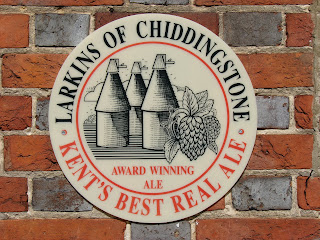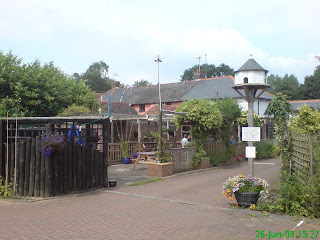


Tuesday, my one and only visit to Earls Court this year. It's more than a few years since I last attended GBBF for the Trade Session. Although strictly speaking I'm no longer actively involved with the licensed trade, I still have quite a few contacts, so it was quite easy getting hold of a couple of tickets. I travelled up with a friend from work, but once inside the hall we soon met up with a number of other West Kent CAMRA members who'd had the foresight to grab a table. We made this our base for the rest of the day, and there were enough of us to ensure the table wasn't left totally unoccupied whilst the remainder of us went off foraging for whichever beers (and food) took our fancy.
My strategy this year was to start off with a few milds and weaker bitters, before moving on to the porters and stouts. Having done this, I would then move across to the imported beers on the Biers sans Frontieres stand. The inter-active beer lists on the GBBF website, which allow one to select and save those beers which take your fancy, and then come back and edit it later on, were a great innovation. How much easier it was to produce one's own "wish list" at the click of a mouse, without having to print off and copy out great chunks of text.
The strategy got off to a poor start, with several of the beers I wanted to sample not available. No problem, I had brought a reserve list, which just happened to be the first one I had knocked up. As this contained over 50 entries, I had sensibly whittled it down somewhat, but in the end it came in handy. The other really good innovation about this year's festival was the use of colourful "chalk-boards", displaying lists of all the beers on sale at each bar - full marks to the person(s) behind this idea.
We missed the announcement of the Champion Beer of Britain (CBOB) results, but whilst I wouldn't want to take anything away from the winners, Rudgate Mild doesn't really strike me as Supreme CBOB. I met up with plenty of old friends, including several members of Maidstone & Mid-Kent Branch. I also had a brief chat with Phil and Debbie Goacher, plus their brewer Simon and his girlfriend.
For lunch I enjoyed a pasty from the Crusty Pie Company, followed by a mature cheddar roll from the Traditional Cheese Company. Much later on, and plenty of beer later, I had an excellent red Thai curry, courtesy of Nuch's Kitchen. I have to say that my two favourite beers of the festival were both from the Czech Republic, and both from the same brewery. Brewed in the Moravian town of Humpolec, Bernard Brewery's excellent Cerne Pivo (dark) and Sveltly Pivo (light), both unpasteurised, and in the case of the latter, unfiltered as well, really hit the spot so far as I was concerned, and have whetted my appetite for a long overdue return visit to the Czech Republic. The best home-produced beers I sampled were Yates Fever Pitch, a 3.9% bitter, Grain Tamarind, a really tasty 5.1% IPA and the Bristol Beer Factory's 4.5% Milk Stout, who's name speaks for itself!
I have been looking at comments posted on other blogs, including those of the festival organisers. Several have drawn attention to the large percentage of female visitors, estimated at around 40%. Whilst I too noticed this phenomenon last year, as an ordinary punter, Trade Day seemed much more of a male preserve, reinforcing my admittedly somewhat prejudiced view of it as a glorified "publicans outing". Nevertheless it was an extremely enjoyable day out, and from CAMRA's point of view a highly successful one, with numbers significantly up on last year. The organisers and all the hard working volunteers should be congratulated for the truly professional event that the Great British Beer Festival is today.
Footnote: now that I've had a couple of days to recover I'm sorry that I won't be attending the festival again tomorrow (Friday). Unfortunately, with a holiday in Bavaria fast approaching I don't really feel justified in spending another full day at Earls Court, much as I would like to. However, I'm extremely heartened by what I experienced, and by all the positive feedback about the event that I've read to date. Well done, CAMRA!













































